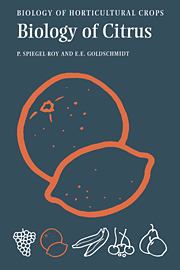6 - Genetic improvement in citrus
Published online by Cambridge University Press: 27 October 2009
Summary
Introduction
Most citrus cultivars grown arose as chance seedlings or bud mutations of existing cultivars. A relatively small number of cultivars of widespread significance have so far originated from breeding programs. The genetics and breeding of citrus were reviewed by Cameron and Frost (1967), Cameron and Soost (1969), Soost and Cameron (1975), Vardi and Spiegel-Roy (1978) and more recently by Soost (1987) and Gmitter et al. (1992). Citrus cultivars are highly heterozygous (Soost and Cameron 1975). Little information has been obtained on the genetic control of traits. Leading cultivars represent subtle gene combinations, often of a highly elevated ‘selection plateau’. Such combinations are disrupted by the sexual process. Many traits are polygenic as to their inheritance, being controlled by numerous genes. The probability of recombining genes in a successful hybrid to recreate the essential characters of a leading traditional cultivar is very low. Citrus breeding is also much hampered by the highly pronounced juvenility in both sexual and nucellar citrus seedlings. A further significant barrier to citrus hybridization and easy transfer of genetic material is the widely encountered apomixis (nucellar embryony) (Frost and Soost, 1968). The ability to cross within or between species in which few or no monoembryonic taxa are available – as in the orange and grapefruit – is highly restricted.
The situation has been somewhat alleviated by the increase in the list of monoembryonic cultivars produced by breeding; this may improve further by the addition of products of somatic hybridization as a result of protoplast fusion.
- Type
- Chapter
- Information
- The Biology of Citrus , pp. 185 - 220Publisher: Cambridge University PressPrint publication year: 1996



